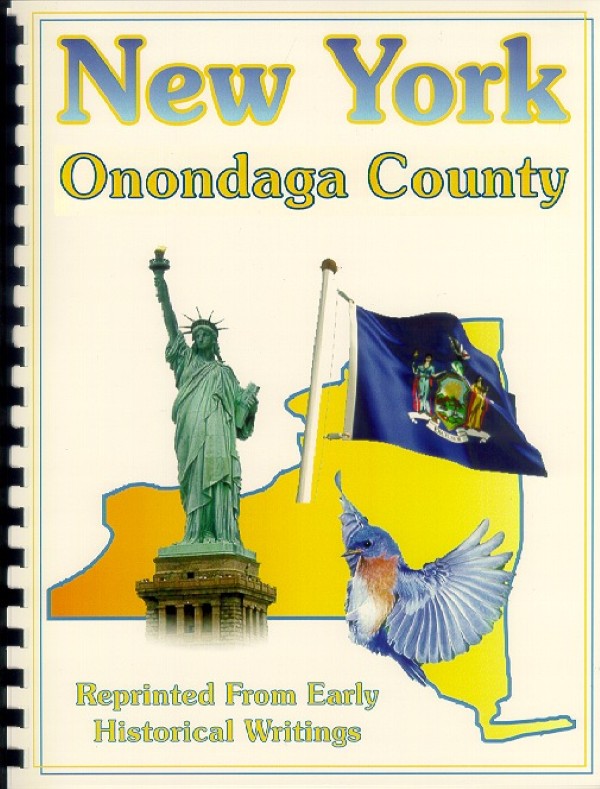Where
the Orangemen Play ...
ONONDAGA COUNTY, NY
ILLUSTRATED BOOKLET
The early days
of Onondaga County and its various towns and townships, including Syracuse,
are recalled through a mixture of colorful tales and factual data in this
NEW 45 Page Booklet, reprinted primarily from two hard-to-find books: the 1841
edition of Historical Collections of the State of New York by John
Warner Barber and Henry Howe, and New York, a Guide to the Empire State,
a WPA project.
The spiral-bound booklet, sold exclusively
on eBay, is one-sided on 60# paper, with the print enlarged for easier
reading. A clear vinyl sheet has been added to protect the front cover.
The communities mentioned include: Amboy,
Apulia, Baldwinsville, Belleisle, Betts Corners, Borodino, Camillus, Canton,
Cicero, Clay, DeWitt, Eagle, Elbridge, Fabius, Fayetteville, Franklinville,
Geddes, Hartsville, Jamesville, Jordan, Kirkville, Lafayette, Little Utica,
Liverpool, Lysander, Macksville, Manlius, Marcellus, Matthews Mills, Onondaga,
Onondaga Hollow, Orisco, Orville, Otisco, Peru, Plainville, Pompey, Salina,
Skaneateles, Spafford, Tulley, Tully, Van Buren, Vesper, and Wellington.
Among the many and diverse topics in the booklet
are: Early Settlers, Customs, Churches, Schools, Newspapers, and Business
Enterprises; Miss Rachel Baker, a remarkable case of devotional somnium
(sleep with religion); the Onondaga Indian Tribe, distinguished both as orators
and warriors, and the Reservation; Evidence of an early Spanish settlement
at Pompey (later proven a hoax), and the Cardiff Giant (a $25,000 hoax);
Rapid Growth of Syracuse after opening of Erie Canal; Salt Production;an ill-fated
French settlement, an Indian Uprising, and a Secret Escape; New York State
Fair; Underground Railroad stops and the Jerry Rescue incident; an Syracuse
early visitor, Charles Dickens; and interesting tidbits on willow weaving,
eel weirs, frogs' leg dinners and teasel raising. A 1940 Syracuse street
map is also included.
The booklet has no index, but some of the
names mentioned are: David Tripp, Gen. A. Danforth, Cyrus Kinne, Billy
McKee, Jenny Mulholland, Conrad Lower, Salmon Sherwood, Phineas Stevens,
William Ward, Azariah Smith, William J. Bulkeley, H. Hickox, James Selkrigg,
A. S. Hollister, Jesse Pound, Samuel Hopkins, Hezekiah Woodruff, Ralph Cushman,
Hiram Kellogg, John Ingersoll, Talcott Bates, Carlos Smith, Amzi Benedict,
John J. Slocum, Charles Morton, D. Bellamy, Abraham Romain, James O. Rockwell
(poet), Ephraim Webster (James Fenimore Cooper's Natty Bumppo?), Major Asa
Danforth, Comfort Tyler, La Sieur Dupuys, the Father Claude Dablon, Father
Simon LeMoyne, Father Joseph Chaumonot, Francis Le Mercier, Father Freemen,
Father Mesnard, Joseph Barber, Pres. Grover Cleveland, Rev. Frederic C.
Huntington, John A. Schaeffer, Baron Von Steuben, Gen. Van Rensselaer, William
George Fargo, Gov. Horatio Seymour, Abraham A. Cuddeback, Dr. W. C. Thomas,
Gerrit Smith, John Anderson Collins, Lydia P. Mott, William Snook, William
Newell, John Fischer, James Geddes, Joshua Forman, John Wilkinson, Thomas
G. Alvord, Vivus W. Smith, Abraham Walton, Thomas Wiard, Nicholas Mickles,
Anthony Will, John D. Gray, Lyman C. Smith, Alexander T. Brown, H.H. Franklin,
John Wilkinson, William "Jerry" Henry (escaped slave), Dr. Samuel J. May
and Gerrit Smith, and the sir names: Foster, Krebs, Adams, de Lauson, Dyer,
Burton, Clark, McCarthy, Appleton, Reed, Olds, Davis, Pardee.
ILLUSTRATIONS depict
the Central part of Manlius; Council House of the Onondagas; Central part
of Syracuse with Erie Canal; a Field of Salt Vats, Salina; Internal View
of a Salt Manufactory; .
The Howe/Barber history covers the development
of this area until about 1841, while excerpts from the WPA book, give a
nostalgic glympse from a 1940 vantage point, including interesting historical
notes, especially as they relate to sightseeing possibilities. There's also
a small map of the area from a 1948 booklet printed by the New York Telephone
Company.
|

